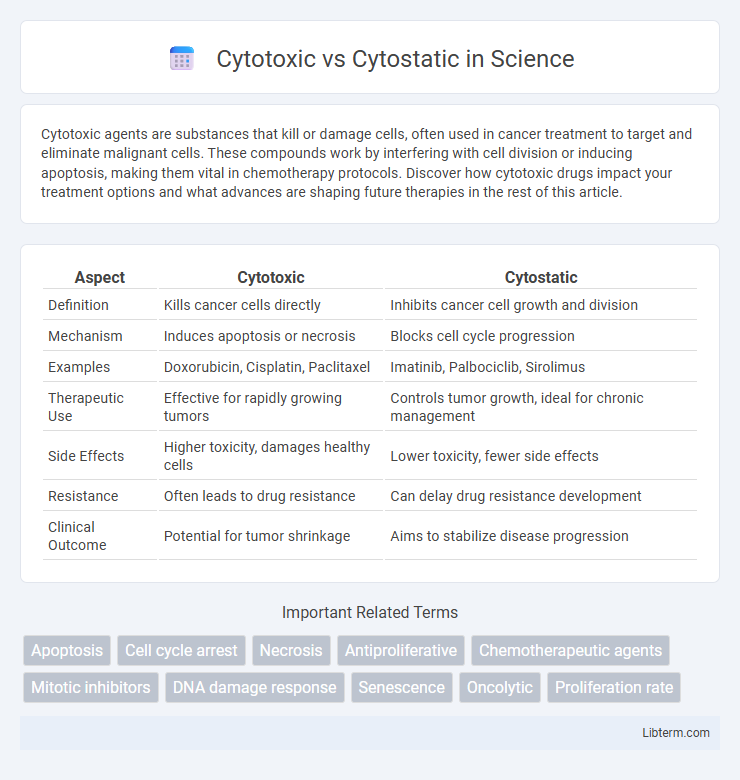Cytotoxic agents are substances that kill or damage cells, often used in cancer treatment to target and eliminate malignant cells. These compounds work by interfering with cell division or inducing apoptosis, making them vital in chemotherapy protocols. Discover how cytotoxic drugs impact your treatment options and what advances are shaping future therapies in the rest of this article.
Table of Comparison
| Aspect | Cytotoxic | Cytostatic |
|---|---|---|
| Definition | Kills cancer cells directly | Inhibits cancer cell growth and division |
| Mechanism | Induces apoptosis or necrosis | Blocks cell cycle progression |
| Examples | Doxorubicin, Cisplatin, Paclitaxel | Imatinib, Palbociclib, Sirolimus |
| Therapeutic Use | Effective for rapidly growing tumors | Controls tumor growth, ideal for chronic management |
| Side Effects | Higher toxicity, damages healthy cells | Lower toxicity, fewer side effects |
| Resistance | Often leads to drug resistance | Can delay drug resistance development |
| Clinical Outcome | Potential for tumor shrinkage | Aims to stabilize disease progression |
Introduction to Cytotoxic and Cytostatic Agents
Cytotoxic agents are chemicals that directly kill or damage cells by interfering with critical cellular functions, often used in chemotherapy to target rapidly dividing cancer cells. Cytostatic agents, in contrast, inhibit cell growth and proliferation without causing immediate cell death, effectively halting tumor progression by inducing cell cycle arrest. Understanding the distinct mechanisms of cytotoxic and cytostatic agents is essential for optimizing therapeutic strategies in oncology and minimizing adverse effects.
Defining Cytotoxicity: Mechanisms and Effects
Cytotoxicity refers to the ability of certain agents or compounds to kill or damage cells by disrupting vital cellular functions such as DNA replication, membrane integrity, or metabolic pathways. Mechanisms of cytotoxicity include inducing apoptosis through caspase activation, generating reactive oxygen species (ROS), and causing direct DNA strand breaks. The effects of cytotoxicity are characterized by cell death, tissue damage, and potential therapeutic applications in targeting cancer cells.
Understanding Cytostatic Activity: How It Works
Cytostatic activity involves inhibiting cell growth and proliferation without causing cell death, typically by arresting the cell cycle at specific checkpoints such as the G1 or G2 phase. This mechanism prevents tumor progression by halting the expansion of cancer cells, contrasting with cytotoxic agents that induce apoptosis or necrosis. Understanding the molecular pathways of cytostatic agents, including their interaction with cyclin-dependent kinases (CDKs) and tumor suppressor proteins like p53, is crucial for developing targeted cancer therapies with potentially fewer side effects.
Key Differences: Cytotoxic vs. Cytostatic Action
Cytotoxic agents kill cells directly by inducing apoptosis or necrosis, leading to cell death, while cytostatic agents inhibit cell proliferation by halting the cell cycle without causing immediate cell death. Key cellular targets of cytotoxic drugs include DNA, microtubules, and mitochondria, resulting in rapid decrease in cell viability. Cytostatic compounds primarily target signaling pathways and cell cycle checkpoints, maintaining cell viability but preventing tumor growth and progression.
Common Cytotoxic Drugs in Clinical Use
Common cytotoxic drugs in clinical use include alkylating agents like cyclophosphamide, platinum-based compounds such as cisplatin, and antimetabolites like methotrexate. These agents disrupt cancer cell proliferation by directly damaging DNA or interfering with cell division, leading to cell death. Their effectiveness is often balanced against toxicity to normal cells, requiring careful dosing in chemotherapy regimens.
Typical Cytostatic Agents and Their Applications
Typical cytostatic agents such as methotrexate, paclitaxel, and vincristine inhibit cell division by targeting specific phases of the cell cycle, effectively slowing or halting tumor growth. These agents are widely used in chemotherapy to treat various cancers including breast cancer, leukemia, and lymphoma by preventing cancer cells from proliferating without necessarily killing them directly. Their application helps manage cancer progression, often in combination with cytotoxic drugs, to improve treatment outcomes and reduce resistance.
Advantages and Limitations of Cytotoxic Therapies
Cytotoxic therapies offer the advantage of directly killing rapidly dividing cancer cells, leading to significant tumor reduction and potential remission in aggressive cancers. These treatments, however, often have limitations such as damaging healthy proliferating cells, resulting in side effects like bone marrow suppression, gastrointestinal toxicity, and hair loss. Resistance development and lack of specificity remain challenges, necessitating combination with other modalities for improved efficacy.
Benefits and Challenges of Cytostatic Treatments
Cytostatic treatments inhibit cancer cell proliferation by blocking cell cycle progression, reducing tumor growth while minimizing damage to normal tissues. Benefits include lower toxicity and fewer side effects compared to cytotoxic therapies, making them suitable for long-term management and combination strategies. Challenges involve potential resistance development and limited efficacy in rapidly progressing tumors, requiring precise patient selection and biomarker-driven approaches.
Clinical Considerations: When to Use Cytotoxic vs. Cytostatic
Cytotoxic agents are preferred in clinical settings requiring rapid tumor reduction or when targeting fast-dividing cancer cells, particularly in aggressive or advanced-stage malignancies. Cytostatic drugs are favored for managing chronic conditions or when disease stabilization is the goal, minimizing toxicity and preserving patient quality of life in long-term treatments. Treatment choice depends on cancer type, progression rate, patient health status, and therapeutic objectives, necessitating personalized oncology approaches.
Future Developments in Cytotoxic and Cytostatic Research
Future developments in cytotoxic and cytostatic research emphasize precision oncology, leveraging molecular profiling and genomic data to tailor therapies that maximize efficacy and minimize side effects. Innovations in nanotechnology and drug delivery systems aim to enhance targeted action of cytotoxic agents while limiting damage to healthy cells, improving patient outcomes. Emerging studies are focused on combining cytostatic inhibitors with immunotherapies to overcome resistance mechanisms and promote sustained tumor suppression.
Cytotoxic Infographic

 libterm.com
libterm.com